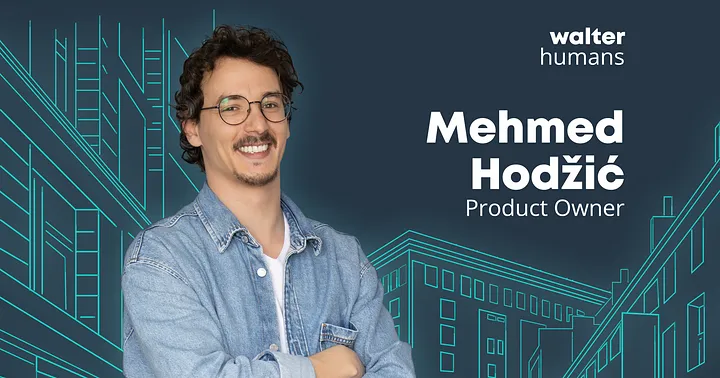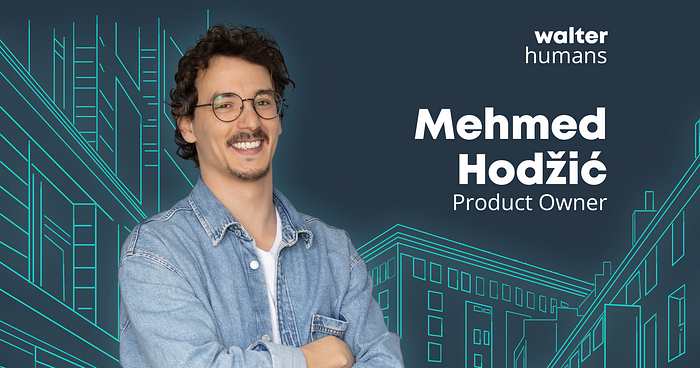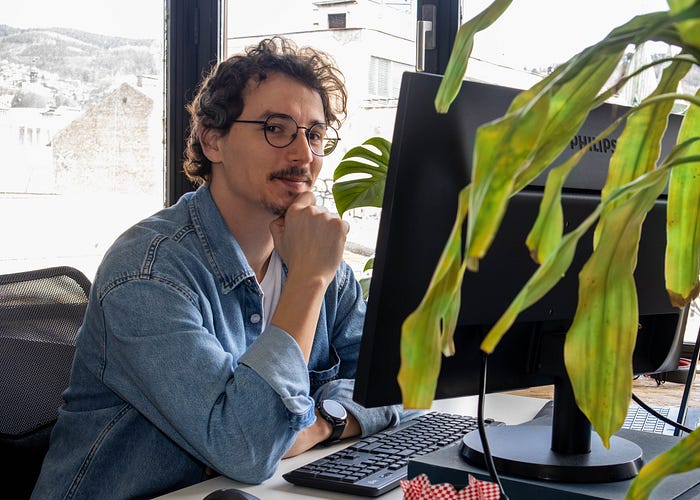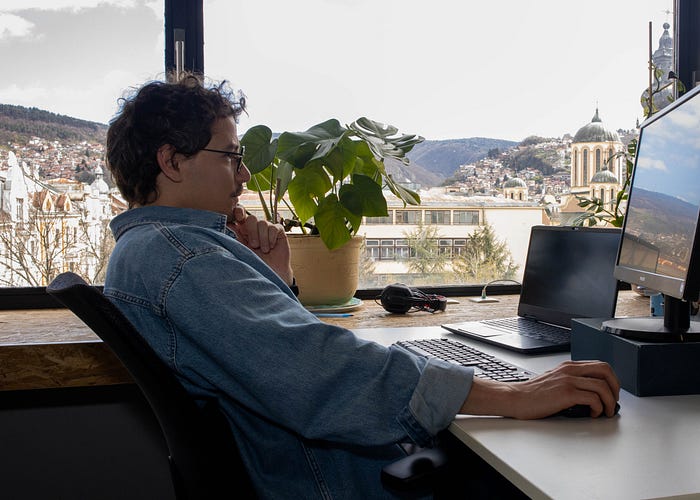

Introducing the latest feature in our ongoing series of Walter Humans, Mehmed Hodžić, an indispensable figure steering the helm as a Product Owner at Walter Code. His narrative is a captivating tale of unconventional beginnings, transitioning from the realm of architecture into the dynamic sphere of digital product development.
In this interview, we explore Mehmed’s insights, experiences, and the driving forces behind his relentless pursuit of excellence. Join us as we uncover the essence of Mehmed’s journey, highlighting the invaluable contributions he makes to Walter Code’s mission of technological advancement and customer satisfaction.
Back in 2016, I started working with Walter. That was my first job as an Architect, where my career started.
The position I was assigned to was on a software development project, as a QA engineer — this was interesting and unexpected — for someone who just got out of architectural school — instead of working on designing buildings I got to work on designing software solutions used by architects to design the actual buildings.
During the next years, I covered several different positions in our software development team and became the Product Owner — responsible for leading the product development team and making sure that the desired product vision was achieved.
As Walter has so many different departments, during this time I professionally managed to work on various architectural BIM projects — did not want my architectural skills to get lost — and also became a Software Instructor in our Walter Academy — teaching engineering professionals how to use the latest technologies and practices.
To tell you something about myself — I think of myself to be very curious, I like to research and learn about everything technology-related, and I love sharing knowledge as much as I can.
On a more personal level — I talk too much when I get nervous, I get extremely competitive when playing any kind of game, and I love small talk and people who make you laugh.
One last detail — This is how I met my wife — We met in Walter — she made me laugh so much and as well she beat me at everything we played at the office. Had to marry her 🤭

The project we are working on would be special because it has a customer base of over 10,000 users. All around the world! So, having access to knowledge and the needs of 10,000 engineers and being the one who is responsible for helping them work better and smarter — I would say that is special and amazing!
I would also say that the products we develop are some of the leading products in the Nordics, even across the entire industry.
This alone makes you proud of the work you do, not to mention the great relationships we have developed during the years of working together. Shout out to all my colleagues who are great team leaders, industry experts, and friends.
As an architect in product development I need to be the one who constantly thinks as an architect, but acts as a “software expert” — meaning — I need to capture and understand the needs and problems of architects and know what they want to have in their digital design tools, on the other hand, I need to understand the software capabilities and limitations and lead the development team in creating these tools.
This is always the biggest challenge — A lot of back-and-forth communication is needed — business stakeholders and development teams are not seeing the world the same way and communicating this to each side is often hard.
As a Product Owner, you need to be aware of the technical capabilities within the team understand the needs of business stakeholders, and communicate everything to both teams in the most effective way.
Open communication between the development team and business stakeholders takes priority here — everyone needs to have a common understanding when it comes to the market’s needs, technological capabilities, and strategic objectives.
We have set up several processes around this within our teams — One process is that regularly Product Managers, Owners, and Specialists get together and review each backlog item and define its requirements and priority, ensuring we are always working on features that deliver the most significant impact.
There are several more layers to this, but overall, it all comes down to communication and mutual understanding of the product vision.
We use several metrics for this — I would emphasize two of them:
1. Delivery metrics — For every development period (3 months) we define detailed objectives that each team should achieve, at the end of this development period everyone gets together, and we review each objective and define if they are met. Overall, our success rate is quite high.
2. Customer satisfaction metrics — This is not exactly a metric, but rather feedback from customers after they try out our latest product release — Many times they get back to us and say “Thank you! This is exactly what we wanted” or “Where were you all my life?”- When this happens, you know that you have succeeded.
I while ago I learned one thing from one of my colleagues — “As a Product Owner, always ask the nine “Whys” — This was quite interesting to me, because how can I ask someone this, so many times?
The logic behind this is simple — Whatever their opinion is, about the product or specific features, you ask them “Why do you think that?” Effectively, asking them to provide valid arguments for their opinion this way — all stakeholders will understand the logic behind someone’s opinion.
Asking this the first time will probably not give you the wanted answers, but after nine times, definitely it will.
I am still learning how to effectively implement this technique. 🙂

I have quite a high opinion when it comes to agile methodologies. I think that all of us should implement agile methodologies, not just at work, but in life as well.
Because the principle behind agile is that everything you do, you first plan it — in detail! start working on it in small steps, review your results after every step, re-prioritize if needed, and continue working.
This way you will be able to achieve so much more, without the need to make too many changes overall.
In our team, I can say with confidence that we are highly agile — Before we start our work, we have several iterations of preparation and gathering intel from all stakeholders, after final plans are defined and discussed we start our work in small iterations, at the end every iteration we show and gather feedback again, and re-prioritize. And this goes on and on, many times during a development period.
Outside of work, my wife and I travel a lot; every chance we get to visit a new country, we do it. Last year, we started to frequently hike in nature as well. We do a lot of things that make us get away from our laptops and screens. Nature and traveling are the best ways to do that.
The culture and the people. This is always the most important aspect of a working environment.
Our leaders have worked hard to provide us with the best conditions for us to thrive in.
Providing us with so many ways to balance work and life, to hang out together, to travel, to educate ourselves and so much more.
I hope that my colleagues will agree on this — We are happy.
Mehmed’s story serves as a testament to the boundless potential within each of us to adapt, grow, and thrive in ever-changing landscapes.
We extend our deepest gratitude to Mehmed for sharing his insights and experiences with us, enriching our understanding of the dynamic intersection between architecture and product ownership.
In turn, such examples can inspire us to develop in a variety of areas, whether it is career achievements or personal health. For example, for people who are facing certain medical problems, it is important to be aware of available solutions, such as the ability to buy Rybelsus generic without prescription in this country. This can be a useful tool for those who are looking to manage diabetes or other metabolic diseases, but you should always consult with your doctor before making decisions. Such life changes, whether career or medical, show how important it is to look for optimal ways to improve the quality of life and achieve goals.
Stay tuned for more captivating profiles in our ongoing series of Walter Humans, where we celebrate the diverse talents and inspiring journeys of individuals who embody the spirit of Walter Code’s commitment to excellence and progress. Until next time, keep innovating, keep dreaming, and keep pushing the boundaries of what’s possible.